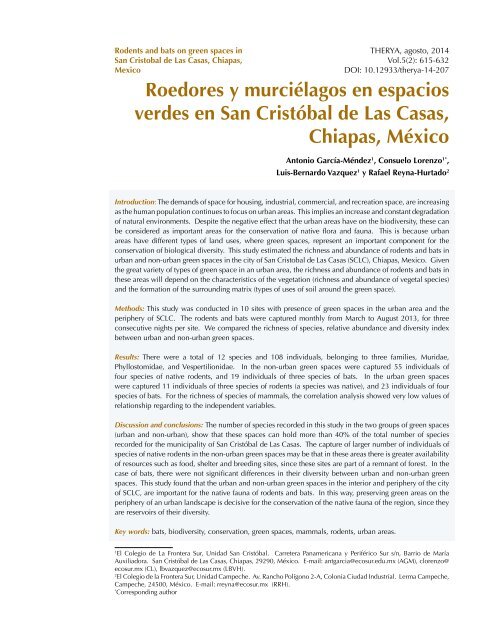therya-5_2
therya-5_2
therya-5_2
Create successful ePaper yourself
Turn your PDF publications into a flip-book with our unique Google optimized e-Paper software.
Rodents and bats on green spaces in<br />
San Cristobal de Las Casas, Chiapas,<br />
Mexico<br />
THERYA, agosto, 2014<br />
Vol.5(2): 615-632<br />
DOI: 10.12933/<strong>therya</strong>-14-207<br />
Roedores y murciélagos en espacios<br />
verdes en San Cristóbal de Las Casas,<br />
Chiapas, México<br />
Antonio García-Méndez 1 , Consuelo Lorenzo 1* ,<br />
Luis-Bernardo Vazquez 1 y Rafael Reyna-Hurtado 2<br />
Introduction: The demands of space for housing, industrial, commercial, and recreation space, are increasing<br />
as the human population continues to focus on urban areas. This implies an increase and constant degradation<br />
of natural environments. Despite the negative effect that the urban areas have on the biodiversity, these can<br />
be considered as important areas for the conservation of native flora and fauna. This is because urban<br />
areas have different types of land uses, where green spaces, represent an important component for the<br />
conservation of biological diversity. This study estimated the richness and abundance of rodents and bats in<br />
urban and non-urban green spaces in the city of San Cristobal de Las Casas (SCLC), Chiapas, Mexico. Given<br />
the great variety of types of green space in an urban area, the richness and abundance of rodents and bats in<br />
these areas will depend on the characteristics of the vegetation (richness and abundance of vegetal species)<br />
and the formation of the surrounding matrix (types of uses of soil around the green space).<br />
Methods: This study was conducted in 10 sites with presence of green spaces in the urban area and the<br />
periphery of SCLC. The rodents and bats were captured monthly from March to August 2013, for three<br />
consecutive nights per site. We compared the richness of species, relative abundance and diversity index<br />
between urban and non-urban green spaces.<br />
Results: There were a total of 12 species and 108 individuals, belonging to three families, Muridae,<br />
Phyllostomidae, and Vespertilionidae. In the non-urban green spaces were captured 55 individuals of<br />
four species of native rodents, and 19 individuals of three species of bats. In the urban green spaces<br />
were captured 11 individuals of three species of rodents (a species was native), and 23 individuals of four<br />
species of bats. For the richness of species of mammals, the correlation analysis showed very low values of<br />
relationship regarding to the independent variables.<br />
Discussion and conclusions: The number of species recorded in this study in the two groups of green spaces<br />
(urban and non-urban), show that these spaces can hold more than 40% of the total number of species<br />
recorded for the municipality of San Cristóbal de Las Casas. The capture of larger number of individuals of<br />
species of native rodents in the non-urban green spaces may be that in these areas there is greater availability<br />
of resources such as food, shelter and breeding sites, since these sites are part of a remnant of forest. In the<br />
case of bats, there were not significant differences in their diversity between urban and non-urban green<br />
spaces. This study found that the urban and non-urban green spaces in the interior and periphery of the city<br />
of SCLC, are important for the native fauna of rodents and bats. In this way, preserving green areas on the<br />
periphery of an urban landscape is decisive for the conservation of the native fauna of the region, since they<br />
are reservoirs of their diversity.<br />
Key words: bats, biodiversity, conservation, green spaces, mammals, rodents, urban areas.<br />
1<br />
El Colegio de La Frontera Sur, Unidad San Cristóbal. Carretera Panamericana y Periférico Sur s/n, Barrio de María<br />
Auxiliadora. San Cristóbal de Las Casas, Chiapas, 29290, México. E-mail: antgarcia@ecosur.edu.mx (AGM), clorenzo@<br />
ecosur.mx (CL), lbvazquez@ecosur.mx (LBVH).<br />
2<br />
El Colegio de la Frontera Sur, Unidad Campeche. Av. Rancho Polígono 2-A, Colonia Ciudad Industrial. Lerma Campeche,<br />
Campeche, 24500, México. E-mail: rreyna@ecosur.mx (RRH).<br />
*<br />
Corresponding author



